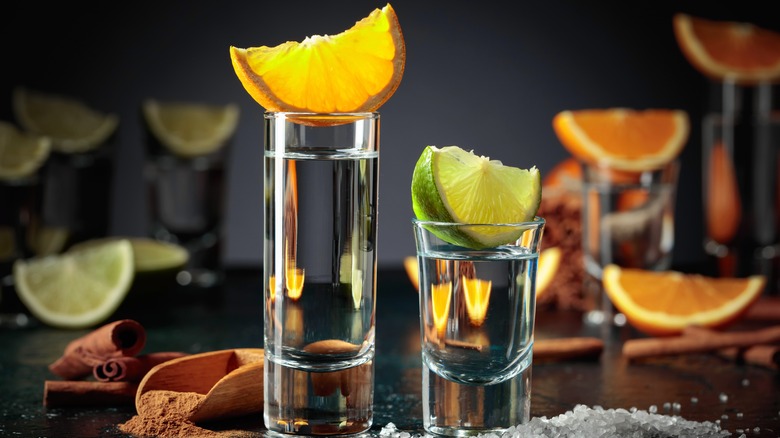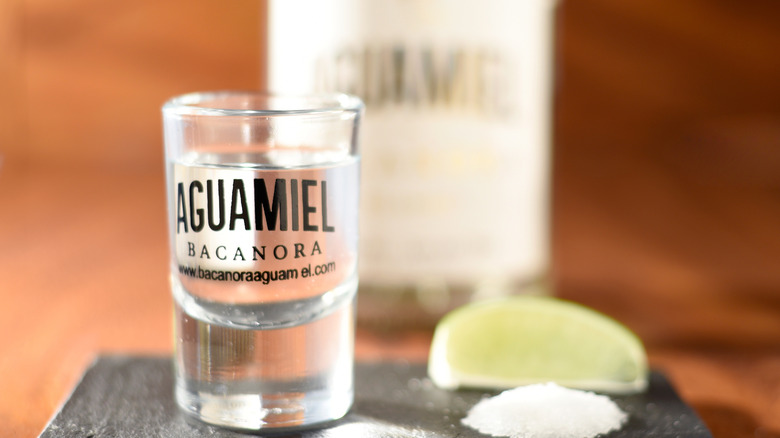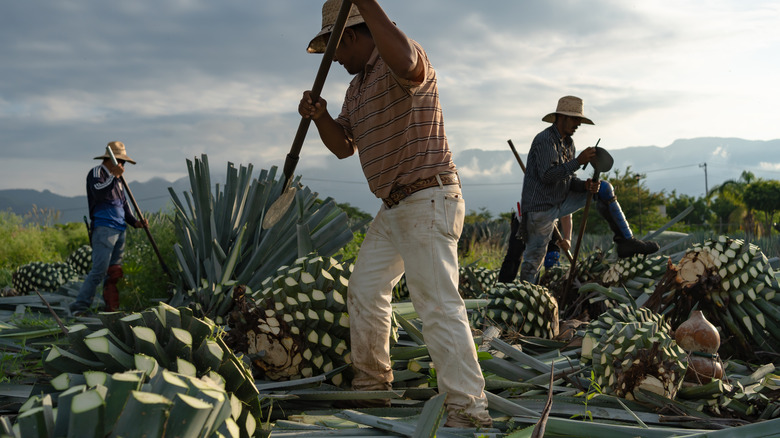Bacanora Is The Tequila-Adjacent Liquor Your Taste Buds Are Begging For
It's not like anyone needs another excuse to drink an agave-based spirit. Whether you are sipping tequila neat from a pretty clay shooter, shaking up some margaritas, or brunching with a Paloma in hand, tequila is definitely a popular move. Tequila is not the only agave-based spirit to look out for though. Of course, mezcal has been having a stateside moment, but have you ever heard of bacanora?
Bacanora comes from the desert of Sonora, Mexico, and is made with agave angustifolia, more commonly called Pacifica or Yaquiana. This single-varietal agave spirit is highly reflective of the land that the plants grow on. Sonora is dry most of the year, but does have a pronounced summer rainy season. It is also very hot with the average high temperature in even the coolest months of the year falling at around 81 degrees Fahrenheit. These harsh conditions, especially the restriction of water for most of the year, stress the plant out which promotes sugar production. Essentially, hardship creates a better flavor, yielding a particularly complex minerality in this type of agave spirit.
The resulting taste of the bacanora varies depending on the season the plant was harvested in, the proximity of the land to the ocean, age of the agave, and how exactly it is distilled. The flavor is typically dry and earthy, and can range from bright, citrusy, and saline, to dark and toasty with notes of coffee and caramel.
What is the history of bacanora?
Bacanora may be one the least commonly known of the agave-based spirits because of its interesting history. Earliest written mentions of bacanora date back to the 1880's where the drink was exchanged with European travelers. By the early 1900's, production of the spirit was one of Sonora's most prominent industries, though meeting labor demands became challenging due to civil war in the area. The final blow for bacanora production came when governor Plutarco Elias Calles prohibited the production and sale of any alcoholic beverages in 1915 due to concerns about moral behavior.
However, production of bacanora did not stop. It just went underground. Producers maintained secret operations, and anyone involved in the process and distribution risked imprisonment if they were caught. The army searched for distilleries to destroy, and bacanora producers were sometimes even killed. The prohibition was not lifted until 1992, and the regional spirit received a Mexican Denomination of Origin in the year 2000.
How is bacanora different from other agave-based spirits?
To be considered bacanora, this agave spirit must be made with only Yaquiana or Pacifica agave and has to be from Sonora. It is made by roasting the heart of the agave, called the piña, in underground ovens. The piñas are then crushed using the traditional method of a grinding wheel, left to ferment for 6 to 12 days, and distilled twice.
Mezcal is an umbrella term and bacanora falls into this category. All bacanoras are mezcals, but not all mezcals are bacanoras. Mezcal can be made in specified regions across thirteen Mexican states with more than 40 types of agave. Accordingly, there is an incredible variety of flavor profiles when it comes to mezcal. Tequila must come from one of five states and is most well-known in Jalisco where the city of Tequila is located. It can only be made from agave tequilana, also known as Blue agave or Blue Weber agave, which is processed by steaming instead of roasting like mezcal. Less commonly known raicilla does not have a Denomination of Origin like its cousins. It comes from the state of Jalisco, is single-distilled, and typically made with Maximilliana or Americana agaves.
Each spirit is truly a reflection of time and place. Sampling bacanora is like taking your taste buds on a quick trip to Sonora and offers an interesting change of pace. But hey, there's nothing wrong with taking a detour to tequila on your way back.


